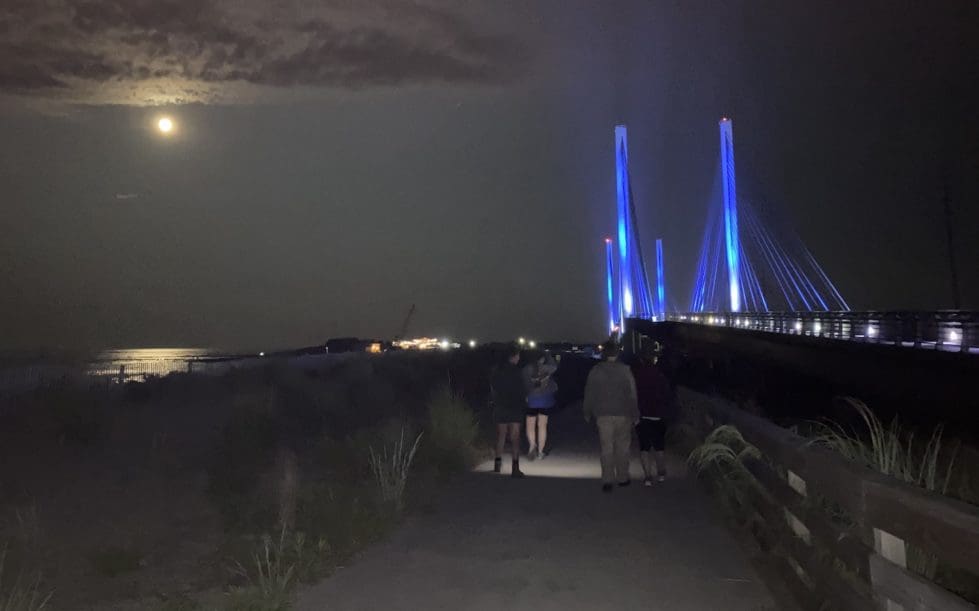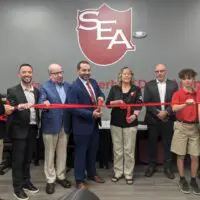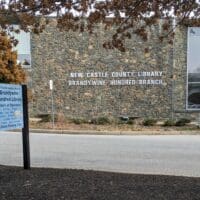

One unique Delaware state parks offering is a look at Indian River Inlet Bridge at night. Photo by Delaware Division of Parks and Recreation.
Delaware state parks are typically open 8 a.m. to sunset, but they also host interesting evening events.
Three types of nighttime events – lantern tours, full-moon hikes and hikes looking for nocturnal creatures – occur at several of the state’s 17 parks.
A fourth – to marvel at the beauty of the Indian River Inlet Bridge – is a specialty of the adjacent Delaware Seashore State Park.
The most popular programs, judging just by how often they occur, are down at the beach, giving vacationers a distinctive alternative to the boardwalk and the outlets.
All the programs can be accessed from a Delaware Division of Parks and Recreation landing page.
The lantern tours are $10, and the other programs $5 or $6. Online registration ends 24 hours prior to the program. After that, interested people need to call the specific park.
“The division receives great feedback from guests on these nighttime programs based on the general excitement of exploring the park in a whole new setting (as they are otherwise not normally open past sunset), spotting/hearing nocturnal animals they don’t normally see, and experiencing the roles of our historical servicemen and servicewomen who protected our region 24/7 (this refers specifically to lantern tours at Indian River Life-Saving Station and Fort Miles),” said Michael J. Globetti, a division spokesman.
Here’s a taste of what you will discover after dusk.


Fort Miles lantern tour. Photo courtesy of Delaware Division of Parks and Recreation.
Delaware State Parks, the moon
Full moon hikes are offered at Bellevue, Brandywine Creek, Delaware Seashore and White Clay Creek.
“Join the park’s naturalists for a hike under the wide open skies and look for the beautiful full moon,” one hike reads. “Learn a bit about the moon and some of the folklore that it stars in. Discover where the moon’s nicknames come from.” They obviously happen about once a month through fall.


Fort Miles lantern tour. Photo courtesy of Delaware Division of Parks and Recreation.
Lantern tours
Lantern tours focus on history, and there’s a lot to cover. The use of the word lantern is evocative: guides might use modern-looking ones.
At Delaware Seashore State Park, the focus is on “what the surfmen went through to save shipwreck victims off the Delaware coast over 100 years ago,” plus “tales of tragedy and mystery” from the logs of the Indian River Life-Saving Station. Most weeks through August.
At First State Heritage Park, the focus is on colonial era, with tours at Christ Church, Old Methodist and Presbyterian cemeteries, plus another one on The Green.
“Discover what stories and spirits may await you among the headstones,” one tour promises. It’s available several times in September and October.
At Fort Miles, people tour Battery 519 and learn about “U-boats on the prowl, sailors in distress” and life for soldiers stationed there. This tour runs weekly through August.
Nocturnal creatures
At Cape Henlopen, the focus is on the “elusive crustaceans” known as ghost crabs.
At Brandywine Creek, the focus is on owls and other nocturnals.
And at Bellevue, it’s whatever “creatures are out and about after hours.”
The ghost crab hikes are weekly through August; the owl prowl is once in July; and the Bellevue walk is monthly in July and August.
Indian River Inlet Bridge
The beautifully lit (and beautifully designed) Indian River Inlet Bridge is the star of its own tour, twice a month in July and August.
“Learn about the dynamic forces that have shaped the inlet over the last 200 years, the tour promises, and a state parks blog by Kenneth Horowitz said those dynamic forces have included dynamite, shovels, dredges and storms.
Inlets naturally move, open and close, unless humanity gets involved.
Share this Post








